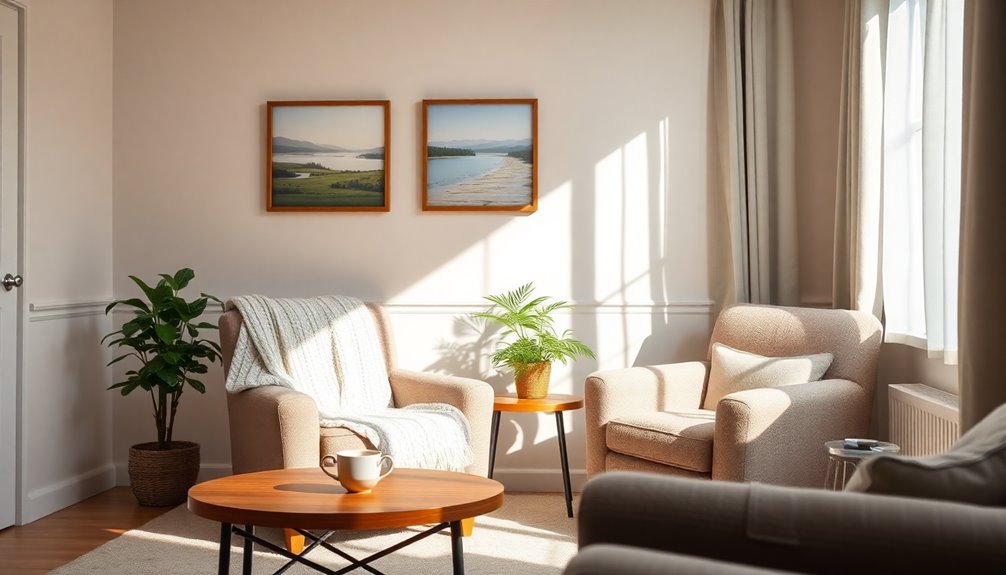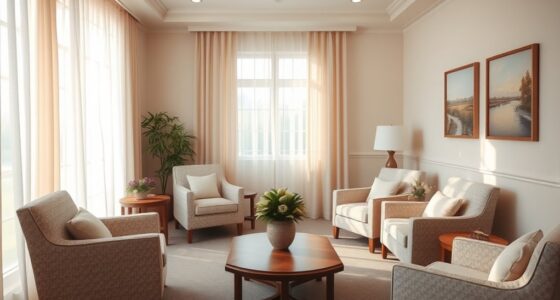Designing a calming environment for Alzheimer's care involves several key strategies. Start by using soft, muted colors and simple layouts to reduce confusion. Adapt lighting for comfort, maximizing natural light during the day. Incorporate familiar objects and nature to evoke positive memories. Balance sound and silence to enhance emotional stability. You can also promote independence through meaningful activities. To discover more effective strategies that can make a significant difference, keep exploring further.
Key Takeaways
- Utilize soft, muted color palettes to create a soothing atmosphere that enhances emotional well-being and reduces anxiety for Alzheimer's patients.
- Incorporate natural lighting and warm-toned bulbs to improve mood and safety while minimizing glare and disorientation.
- Design simple, clutter-free layouts that facilitate navigation and promote familiarity, helping to reduce confusion and agitation.
- Integrate familiar objects and personal mementos to reinforce identity and evoke positive memories, fostering emotional comfort.
- Manage sound levels by using calming music and creating quiet zones to promote tranquility and emotional balance.
Understand the Impact of Environment on Alzheimer's Patients
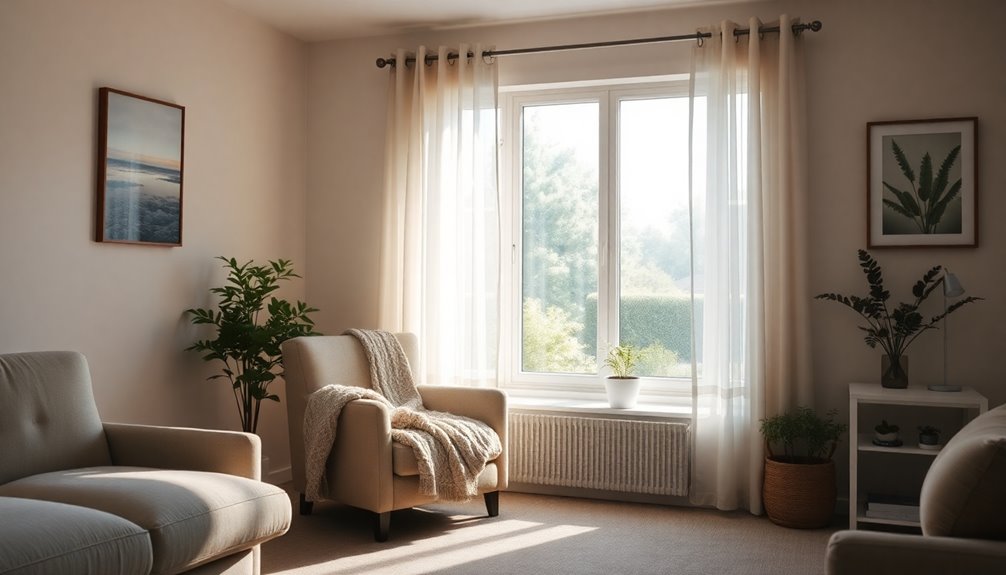
When you consider the care of Alzheimer's patients, it's crucial to recognize how the environment shapes their behavior and emotions. For individuals with Alzheimer's, a well-designed environment can greatly reduce confusion and agitation.
Creating a calming environment involves incorporating elements like natural light and quiet zones, which enhance mood and cognitive function. Structured spaces promote familiarity and safety, helping decrease anxiety and reliance on medications.
Adding nature elements, such as plants or garden views, provides sensory stimulation and fosters tranquility. Personalizing spaces with familiar objects can evoke positive memories, reinforcing identity and enhancing emotional well-being.
Use the Power of Color & Design in Calming Environments

When designing a calming environment for Alzheimer's care, the choice of color and layout plays an essential role.
You'll want to focus on soft, muted color palettes that create a soothing atmosphere and simple layouts that make navigation easy.
Keeping the space clutter-free will help reduce anxiety and promote a sense of peace.
Soft, Muted Color Palettes
Soft, muted color palettes can make a world of difference in creating a calming environment for individuals with Alzheimer's. By incorporating gentle hues, you help reduce confusion and promote a sense of safety.
Research shows that light, warm tones foster a soothing atmosphere, decreasing anxiety levels and enhancing emotional well-being. It's important to avoid harsh colors and complex patterns, as these can lead to visual confusion and distress.
Instead, focus on a cohesive color scheme for furniture, walls, and decorative elements to reinforce familiarity and comfort. While soft, muted colors create peace, consider using high-contrast elements sparingly to delineate spaces without overwhelming the senses.
This thoughtful approach guarantees a nurturing environment for those in your care.
Simple Layouts and Navigation
Creating a simple layout is essential for fostering a calming environment for individuals with Alzheimer's, as it prioritizes clear pathways and reduces clutter. By arranging furniture to facilitate navigation and social interaction, you create spaces that feel safe and orderly. Using high-contrast colors helps distinguish areas, while soft, muted tones maintain tranquility. Incorporate visual cues, like signs or symbols, to guide individuals easily through their surroundings. Regular engagement in mindfulness practices can further enhance emotional stability for individuals with Alzheimer's, promoting a sense of calm and well-being.
| Key Elements | Purpose |
|---|---|
| Clear Pathways | Minimize confusion |
| Soft Colors | Promote calm environment |
| High-Contrast Colors | Aid visual differentiation |
| Visual Cues | Reduce anxiety and disorientation |
Implementing these strategies will help reduce anxiety and enhance mobility for those with Alzheimer's.
Clutter-Free Space Design
Designing a clutter-free space not only enhances the aesthetics but also greatly improves the emotional well-being of individuals with Alzheimer's. By creating a calm environment, you can reduce confusion and anxiety, allowing residents to thrive.
Consider these key elements for effective clutter-free spaces:
- Use soft, muted tones to promote calmness.
- Avoid harsh colors and busy patterns to prevent agitation.
- Opt for simple layouts to enhance navigation.
- Incorporate comfortable textures for tactile comfort.
- Maintain a sense of order for safety and reassurance.
These strategies help individuals with dementia engage in daily activities and foster a supportive atmosphere, ultimately contributing to a more peaceful living experience. Additionally, implementing behavioral management strategies can further enhance the effectiveness of a calming environment.
Adapt Lighting Techniques for Comfort & Orientation
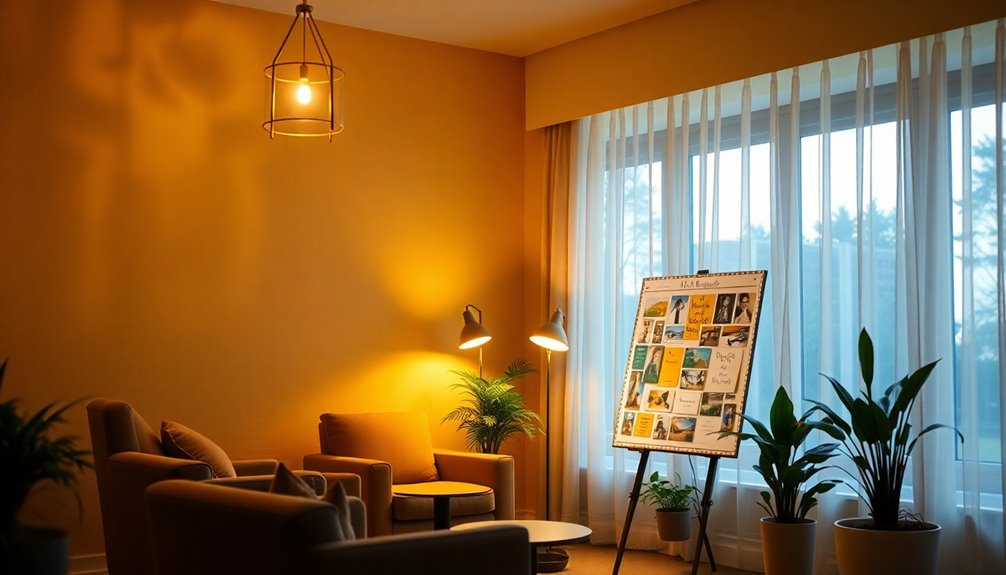
Effective lighting techniques can greatly enhance comfort and orientation for individuals with Alzheimer's.
Prioritize adequate lighting by maximizing natural light during the day to uplift mood and cognitive function. Choose warm-toned bulbs instead of harsh fluorescents to minimize glare, creating a safe, secure environment that reduces confusion.
At night, use nightlights or dimmers to guarantee safe navigation and prevent disorientation, allowing residents to move independently. Implement multiple levels of indirect lighting to control ambiance, which helps alleviate agitation, especially during late afternoons.
Consistent lighting strategies not only prevent disorientation but also enhance security, promoting a calming atmosphere that supports the emotional well-being of those with Alzheimer's.
Incorporate Nature & Familiar Objects

An inviting environment goes beyond lighting; incorporating elements of nature and familiar objects can greatly enhance the comfort of individuals with Alzheimer's. By integrating these elements, you create a calming environment that promotes emotional well-being.
Consider these strategies:
- Add indoor plants or flowers for sensory stimulation.
- Guarantee access to views of gardens or natural landscapes.
- Personalize spaces with family photos and cherished mementos.
- Create indoor gardens or provide easy access to outdoor spaces.
- Use familiar items to create a grounding experience.
These approaches not only reduce feelings of isolation and anxiety but also evoke positive memories, reinforcing identity and promoting tranquility.
Incorporate nature and familiar objects to foster a nurturing atmosphere for those in your care.
Utilize Sound & Silence for Emotional Balance
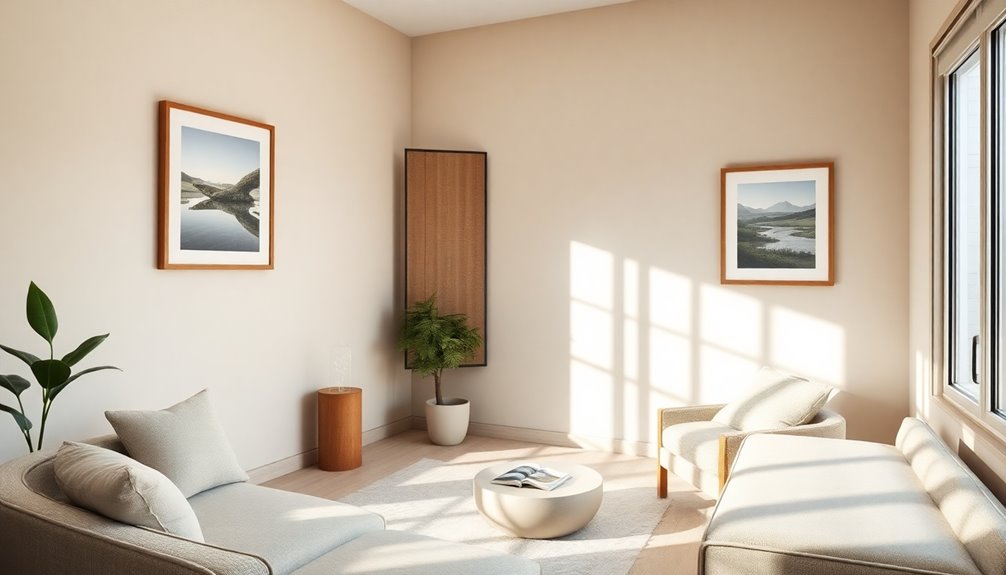
Creating a soothing atmosphere involves careful attention to the sounds that fill the space. Sound management is essential for individuals with Alzheimer's, as excessive noise can cause distress and confusion.
Incorporating soft background music can ease anxiety and promote tranquility, enhancing the overall calm environment. Additionally, natural sounds, like birdsong, provide comforting auditory cues that support emotional well-being.
Designating quiet zones within your space allows residents to decompress from sensory stimulation, fostering a sense of safety and balance.
By thoughtfully balancing sound and silence, you create an environment that nurtures emotional stability, helping those with Alzheimer's feel more at ease and connected.
Prioritize these auditory elements to greatly improve their quality of life.
Create a Calm Environment With Minimal Clutter
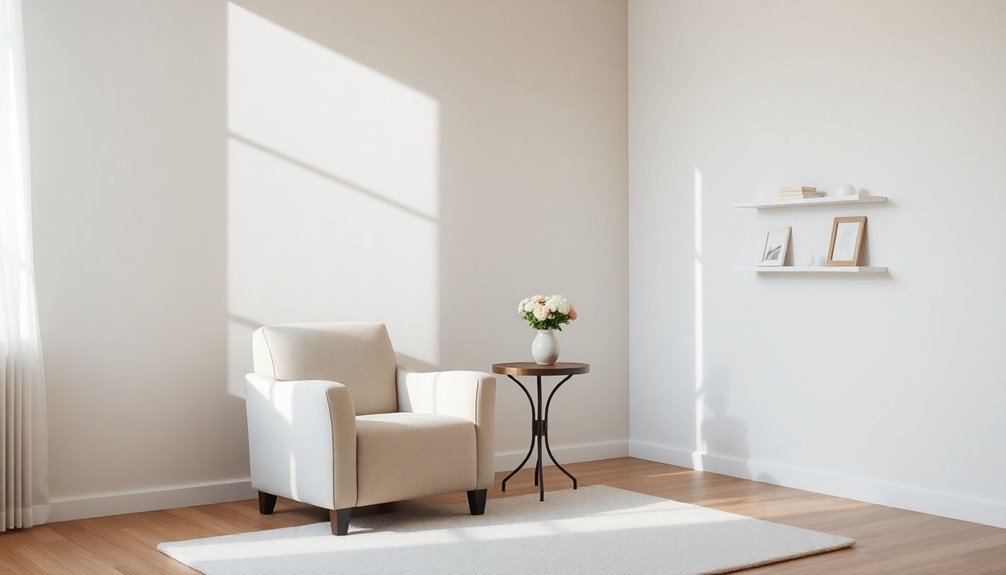
To create a calming environment for someone with Alzheimer's, you should declutter regularly and keep personal belongings organized.
Reducing distractions helps minimize anxiety and confusion, allowing for a clearer path to navigate their space.
Declutter Regularly
A clutter-free environment is essential for individuals with Alzheimer's and dementia, as excessive visual stimuli can lead to confusion and agitation.
To create a calm, safe space, it's important to declutter regularly. Here are some effective strategies:
- Remove non-essential items that create visual noise.
- Designate specific storage areas for personal belongings.
- Keep pathways clear to prevent trips and falls.
- Limit furniture and decorations to maintain simplicity.
- Regularly assess the environment to guarantee only necessary items are present.
Organize Personal Belongings
Organizing personal belongings can transform a space into a calming sanctuary for individuals with Alzheimer's. By reducing clutter, you create a calm environment that promotes order and security.
Start by grouping personal items in an accessible way, ensuring familiarity and comfort. Use visual cues, like labels with clear text or images, to help individuals easily locate their belongings and minimize confusion.
Incorporate cherished items, such as family photos, to evoke positive memories and enhance emotional well-being. Maintain a consistent layout with minimal decorative distractions, allowing for safe and confident navigation.
Foster Engagement Through Meaningful Activities
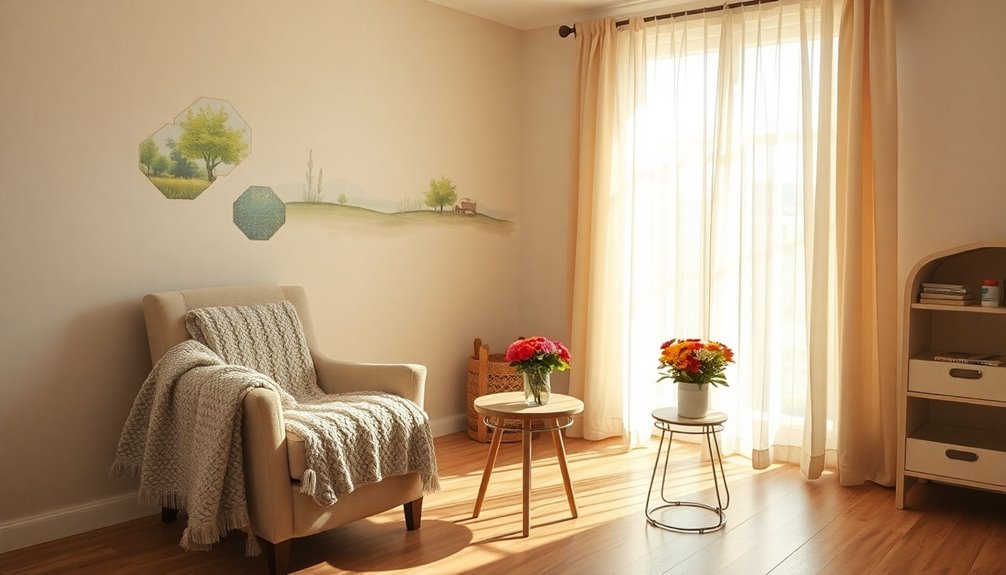
Engaging individuals with Alzheimer's in meaningful activities can greatly enhance their emotional satisfaction and cognitive function. By incorporating activities tailored to their past interests, you can help reduce agitation and promote a sense of accomplishment.
Consider these ideas to foster engagement:
- Gardening to evoke positive memories
- Arts and crafts for creative expression
- Light exercise to promote physical health
- Structured tasks with clear steps for easy navigation
- Social interaction opportunities to boost mental well-being
These meaningful activities not only improve quality of life but also reinforce identity for individuals living with cognitive impairments.
Regularly adapting the activities to suit their evolving interests guarantees continued engagement, making a significant difference in their daily lives.
Promote Independence While Ensuring Safety
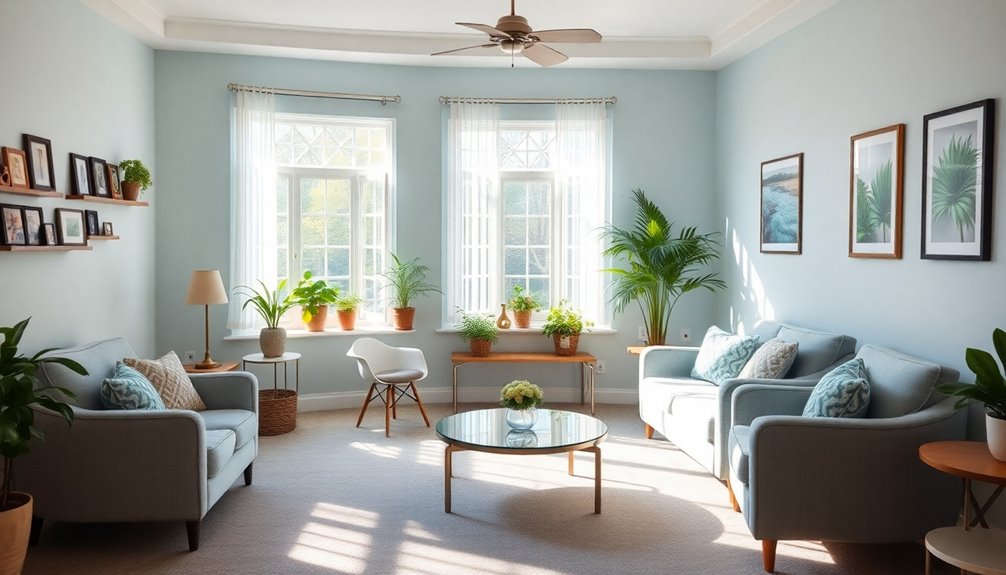
To promote independence while ensuring safety, you can use visual cues to guide navigation throughout the space.
Structured daily routines help individuals feel secure and confident in their activities, making it easier for them to engage meaningfully.
Visual Cues for Navigation
Creating a navigable environment is essential for individuals with Alzheimer's, as it can greatly enhance their independence and safety.
Using visual cues and high-contrast colors strategically can reduce confusion while maneuvering. Here are some effective strategies:
- Use clear signage to indicate important areas, like restrooms.
- Incorporate color-coded zones to help identify different spaces.
- Design continuous loops or circular paths for a sense of security.
- Guarantee good contrast between floors, walls, and ceilings to aid mobility.
- Replace doors with privacy curtains in toilet rooms for better visibility.
Structured Daily Routines
Structured daily routines can markedly enhance the quality of life for individuals with Alzheimer's, as they provide a sense of predictability and security. By implementing structured daily routines, you help reduce anxiety and create a comforting environment.
Tailoring these routines to each person's unique needs fosters engagement and encourages participation in familiar activities. Using visual aids, like pictures or symbols, can assist individuals in understanding daily tasks more easily.
Consistency in meal times, medications, and activities not only enhances comfort but also promotes independence, allowing them to anticipate and take part in their day.
Regularly evaluating and adjusting routines with a holistic approach guarantees a balance between independence and safety, ultimately leading to improved well-being for those with Alzheimer's.
Encourage Meaningful Engagement Activities
While it's essential to maintain safety for individuals with Alzheimer's, engaging them in meaningful activities can greatly enhance their sense of independence and well-being.
By tailoring activities to their interests and abilities, you'll promote engagement and emotional satisfaction. Here are some ideas to take into account:
- Gardening for a connection to nature
- Arts and crafts to express creativity
- Light exercise to promote physical health
- Cooking simple recipes for sensory stimulation
- Group activities for social interaction
Incorporating visual cues and simplified instructions can aid understanding, ensuring a positive experience. Digital creativity can also be leveraged to design personalized activities that resonate with individual preferences.
Regularly monitor their responses to adapt activities, ensuring they remain enjoyable and safe.
This approach not only provides care and support but also fosters a fulfilling environment for individuals with Alzheimer's.
Implement Sensory Stimulation for Enhanced Comfort
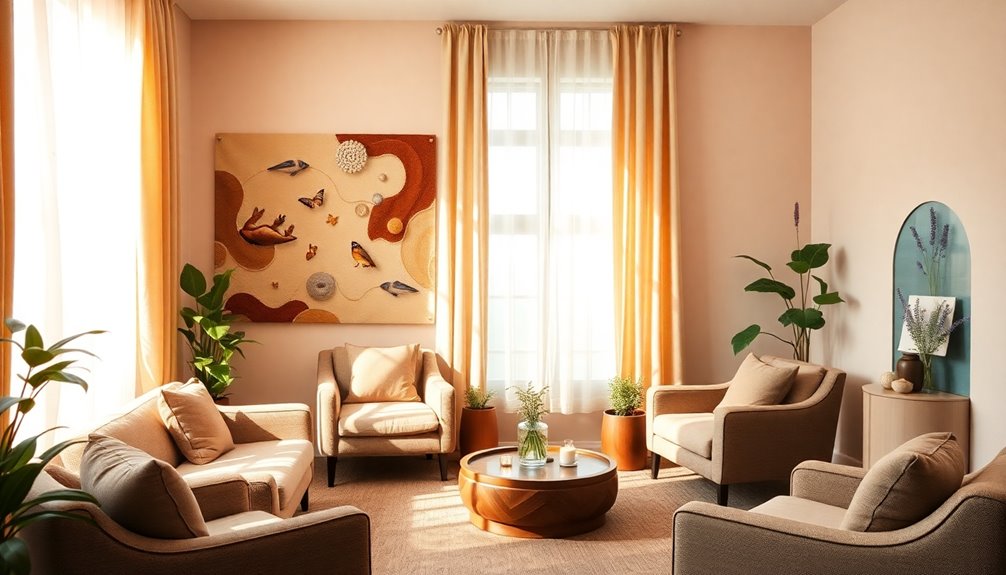
To enhance comfort for individuals with Alzheimer's, implementing sensory stimulation is essential.
Consider incorporating soothing music, like soft melodies or nature sounds, to reduce anxiety and promote relaxation. Calming scents, such as lavender or chamomile, can also evoke positive emotional responses, creating a supportive environment in dementia care.
Offering tactile experiences, like soft fabrics or sensory blankets, soothes agitation through comforting physical touch. Engaging residents in gentle hand massages or familiar activities, such as art or gardening, stimulates sensory responses and improves emotional well-being. Additionally, integrating an air purifier with HEPA filtration can help maintain a clean environment, further promoting comfort and well-being.
Personalize Spaces to Reflect Individual Preferences
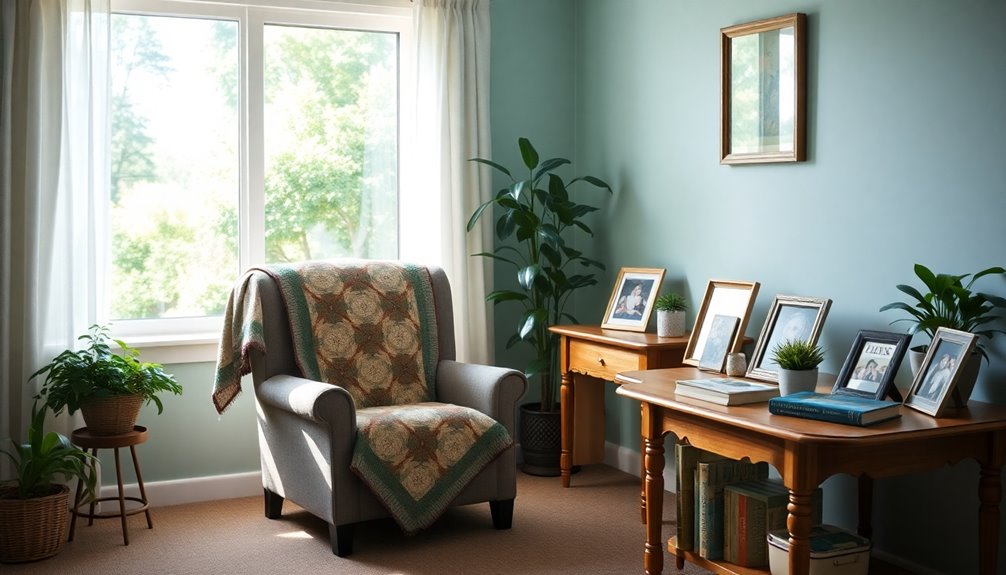
Creating a calming atmosphere goes hand in hand with personalizing spaces to reflect individual preferences. By tailoring environments to the individuals, you enhance their sense of identity and comfort.
Here are some effective strategies to personalize spaces:
- Display family photos and cherished mementos.
- Use favorite colors and artworks in decor.
- Incorporate familiar textures and materials in furnishings.
- Encourage participation in the decoration process.
- Design areas that reflect hobbies, like gardening or crafting.
These efforts not only promote high-quality care but also evoke positive memories and emotional stability. Additionally, consider integrating elements that cater to sensory stimulation, such as familiar textures that can provide comfort and enhance the overall environment.
When spaces feel familiar and comforting, individuals with Alzheimer's can experience reduced anxiety and a greater sense of belonging.
Frequently Asked Questions
What Are 5 Strategies to Create an Appropriate Environment for a Person With Dementia?
Creating an appropriate environment for a person with dementia involves a few key strategies.
First, you can use high-contrast colors to enhance visibility.
Next, design clear pathways to help with navigation.
Soft lighting can reduce agitation, while keeping spaces clutter-free promotes safety.
Finally, incorporating natural elements, like plants, can create a calming atmosphere.
Personal touches, like familiar items, can also evoke positive memories and reinforce their identity, making the space more comfortable.
How to Design a Dementia Friendly Care Environment?
Imagine walking into a care facility where residents feel at ease and oriented.
To design a dementia-friendly environment, you can use high-contrast colors to mark different areas, making navigation easier. Soft, indirect lighting helps reduce anxiety, while natural elements like gardens promote calmness.
Creating continuous pathways encourages safe wandering, allowing residents to explore without fear. Prioritizing these elements fosters a safe and welcoming space that enhances the quality of life for individuals with dementia.
How Would You Create a Therapeutic Environment for a Person With Dementia?
To create a therapeutic environment for someone with dementia, you'll want to focus on simplicity and comfort.
Use soft colors that soothe rather than jar the senses. Incorporate natural light and guarantee spaces are clutter-free, allowing for easy navigation.
Arrange furniture to encourage social interactions without overwhelming them. Add elements of nature, like plants, for a calming touch.
Finally, create cozy areas where they can relax and feel secure, enhancing their overall well-being.
What Is the Best Environment for Alzheimer's Patients?
Creating the best environment for Alzheimer's patients is like crafting a safe harbor amidst a stormy sea.
You'll want to use soft, muted colors and avoid busy patterns to keep things calm. Clear pathways and personal mementos help them feel secure and connected.
Incorporate natural light to regulate their rhythms, and consider outdoor spaces with sensory elements that nurture their mood.
Each detail can anchor them in a comforting reality, reducing confusion and agitation.
Conclusion
Creating a calming environment for Alzheimer's care is like cultivating a peaceful garden; each element nurtures the well-being of your loved one. By carefully considering color, light, sounds, and personal touches, you can transform their space into a soothing sanctuary. Remember, even small changes can make a big difference in their daily experience. With patience and creativity, you can help them feel more at ease, promoting comfort and connection in their world.
